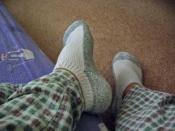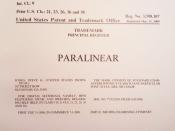2. For hypothetical reasons, lets call this new sock company "Blissfeet". Various types of intellectual property are available to protect their new product. The company must first develop a trademark, synonymous with the brand name. The meaning behind this unique, clever name, (which is what distinguishes an effective from a non effective trademark) is: Bliss (as in happiness) feet (these socks will make your feet happy). Additionally, the word bliss reminds us of the word blister, which is what these socks are made to prevent. Along with a pictorial logo, (a white sock with a red heart wrapped around both the heal and the side of the foot- the most common locations for blisters to occur) Blissfeet's trademark becomes easily recognizable in the consumer marketplace. No legal formalities precede the creation of this trademark, but it is necessary to conduct a trademark search to assure that this logo and name are original.
This imposes costs of investigation, as well as costs of advertising the new name. Trademark registration is an option, usually statewide, but sometimes federally, and would probably not be necessary in this initial stage, because it is quite expensive for a new company. A second option is copyrighting the product, which provides an owner with the exclusive rights to reproduce a certain work for a specified period subject to some basic limits. Ideas and technology are generally not protected by copyrights. Making socks, which prevent blister, is not a new industry, so copyrights may not apply here. Patents are another form of intellectual property, which may be useful for Blissfeet. As touted in the Field article, taking measures to develop loyalty and goodwill may be useful, in addition to preventing a competitor from selling an identical, but cheaper blister prevention sock. If the creators of Blissfeet have discovered some new way of protecting feet from blisters (i.e. a new/ blend of synthetic fibers) they may choose to patent this idea, before others can produce and profit from this discovery. An attorney or an agency must conduct a patent search. This is to prevent patent infringement. Blissfeet can choose to license its product, once they are in a high production mode. Blissfeet would license the right to a licensee to use the property for identifying, advertising, and promoting its products. They may do this as an additional source of revenue, while posing little risks to the company itself. Finally, the creators may decide to keep the origin and production ingredients of fabric x a trade secret. Those in charge can impart a code of confidentiality among employees and producers. A trade secret cannot be patented though, because it would then be public information. If Blissfeet thinks that their idea is novel and unique and will be successful for a long time, they could possibly keep their production strategy and materials as a trade secret, although this is quite unlikely in the apparel business. In turn, Blissfeet must have real, tangible secrets for their socks, thus differentiating them from other sock companies. I recommend Blissfeet use the combination of a trademark and a patent. A trademark is useful for consumer recognition purposes. Customers remember a product if a descriptive, relevant, yet striking association is present Consumers will especially remember a product, that claims to tenderly care for their active feet. A patent will allow for the reduction of competitors, until the name and product are firmly established.




